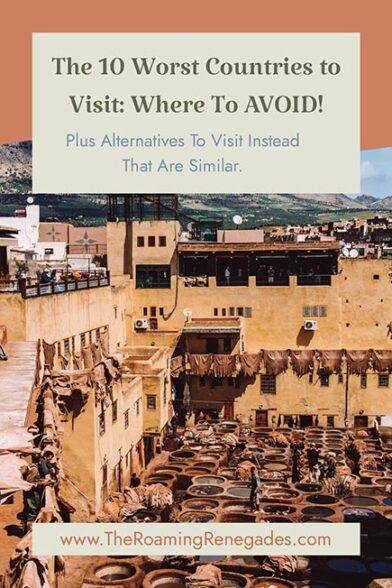Traveling to new countries offers enriching experiences, but it’s essential to approach these journeys with an understanding of the challenges that may lie ahead. While manny destinations captivate tourists with their beauty and culture, certain countries present significant hurdles that can detract from the overall travel experience. In this article, we explore the “Top 10 Worst Countries to Visit,” shedding light on the various obstacles travelers might face, including safety concerns, political instability, inadequate infrastructure, and health risks.
Rather than painting these countries in a solely negative light, our aim is to foster awareness and empathy. Many of these regions struggle with complex issues that shape the realities faced by locals and visitors alike. By recognizing these challenges, we can better prepare for our travels, appreciate the resilience of those living in challenging circumstances, and consider how we can contribute positively during our visits.Join us as we delve into the critical factors that make these countries especially challenging travel destinations, equipping you with the knowledge needed for informed decision-making and safe travels.
Understanding the Safety Concerns and Political Instability in Challenging Travel Destinations
traveling to destinations marked by safety concerns and political instability necessitates a cautious approach. While the allure of experiencing diverse cultures and landscapes is strong, travelers must educate themselves about the specific risks involved. Factors that often contribute to safety concerns include:
- Political Unrest: Protests, riots, or governmental changes can escalate unexpectedly, impacting travelers.
- Crime Rates: High levels of theft, violence, and scams can pose serious risks.
- Health Risks: Inadequate healthcare systems and the spread of diseases can compromise traveler safety.
- Natural Disasters: Certain regions are susceptible to earthquakes,floods,or other natural phenomena that can disrupt travel plans.
Moreover, an understanding of the local habitat is crucial. Travelers should familiarize themselves with the cultural nuances and political climates of these regions. Analyzing the current situations through credible news sources can offer insight into shifting dynamics. Below is a simplified overview of essential safety pointers for anyone considering a visit to challenging travel destinations:
| Country | Key Safety Concern | Travel Advisory Level |
|---|---|---|
| Example Country A | Political Turmoil | High |
| Example Country B | High Crime | Moderate |
| example Country C | Health Crisis | Warning |
Ultimately,it’s crucial for travelers to weigh their desire to explore against potential risks. Gezify believes in empowering travelers with data to make informed decisions,ensuring a safer journey even in less stable regions. Engage with local communities and abide by travel advisories to navigate these complex terrains more effectively.
Navigating Cultural Barriers and Infrastructure issues for a More informed travel Experience
Traveling to certain destinations can reveal a complex landscape of cultural barriers and infrastructural challenges that may not be immediately apparent to the untrained eye. Visitors may encounter subtle yet significant differences in social norms, such as expectations surrounding personal space and dialog styles, which can lead to misunderstandings. Additionally,issues with infrastructure—including unreliable public transportation,limited access to basic services,and language barriers—frequently enough exacerbate these cultural misunderstandings. For example, in regions where local customs dictate a slower pace of life, tourists might perceive service delays as unprofessional rather than an intrinsic part of the culture. To navigate these hurdles effectively, consider the following tips:
- Research Local Customs: Familiarize yourself with the social etiquette and traditions of your destination. Understanding these nuances can greatly enhance your interactions.
- Learn Basic Phrases: Knowing a few key phrases in the local language can go a long way in bridging communication gaps and showing respect for the culture.
- utilize Local Resources: Relying on local guides or apps specifically designed for travelers can provide invaluable insights into both cultural and infrastructural elements, especially when navigating unfamiliar areas.
Moreover,it’s critically important to advocate for more reliable infrastructure,such as improved transportation routes and better communication networks,which not only benefit travelers but also enhance the quality of life for local communities. In places where challenges abound, embracing a patient and empathetic mindset allows travelers to foster a deeper connection to the culture while overcoming hurdles. In the pursuit of more informed travel experiences, platforms like Gezify can serve as a repository of knowledge, allowing individuals to prepare for the realities they may face while traveling. Instead of viewing these challenges as deterrents, consider them stepping stones to a richer, more profound understanding of the world.
| Country | Cultural Barrier | Infrastructure Challenge |
|---|---|---|
| Country A | Direct communication is frowned upon | Limited public transit options |
| Country B | High-context communication | Inconsistent internet access |
| Country C | Strong respect for hierarchy | Poor road conditions |
while the countries highlighted in this article may present significant challenges for travelers, it’s crucial to approach these destinations with empathy and understanding. Each nation has its own unique circumstances that contribute to its difficulties, often shaped by historical, political, and social factors. Rather than condemning these countries, let’s focus on fostering greater awareness and supporting local communities. Traveling with sensitivity and respect can help bridge gaps and encourage positive change. Ultimately, informed travelers can contribute to the dialogue that fosters growth and enhancement in even the most challenging environments.
